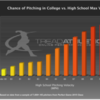I thought other posters or just folks browsing might be interested in this information.
The idea was to see what is really required, velocity-wise, by HS senior fall, using real data that is publicly available with respect to actual players. (Of course, there are other factors to pitching than simply velocity, but velo is an important component).
Below is a list of the max velocity recorded by PG for all RHP on certain current college rosters (available online) who also (1) are in the PG database and (2) had a velocity recorded during the summer before senior year, or in Sept - Jan of senior year.
In a few cases, the highest velocity was actually earlier in their high school years, but if there was a velo in the PG database from May of HS junior year to January of HS senior year, I included the kid and used the highest velocity. Also, in a couple cases, the kid pitched a PG event after graduating high school, and reached a higher velocity, but I did not include that higher velocity, on the theory that 99% of the kids are recruited before they graduate from high school.
If the kid's only PG velo was from earlier (for example, summer after HS freshman year), I did not include him because I didn't want to skew the numbers lower. Same thing with kids who are on a current roster but are noted as a transfer from another college. For two-way players, I included them if RHP was listed first, under the theory that their pitching played a significant role in their recruitment.
Of course, there are also RHP on every roster who aren't in the PG database, or who had no velocity readings from the summer before senior year, or senior fall -- and for some rosters, it was the majority of pitchers. Since I had no easy way of getting data on those kids, I did not include them.
Anyway, here is the information:
POWER 5
- Duke (ACC): 87 (Glavin); 89 (Davis); 90 (Kovachik); 92 (Blum); 93 (Williams); 94 (Pesto)
- Notre Dame (ACC): 87 (Vorsheck); 88 (Smoyer); 88 (Hearne); 89 (Connolly); 89 (Combs); 89 (McCarty); 90 (Solomon); 90 (Hock); 91 (Bielak); 91 (Ruibal); 92 (Bass)
- Virginia (ACC): 85 (Shambora); 89 (Harrington); 90 (Bettinger); 90 (Page); 91 (Doyle); 92 (Roberts); 92 (Murdock); 94 (Sperling); 94 (Casey)
- Wake Forest (ACC): 76 (Casstevens); 81 (Awad); 86 (Dunshee); 87 (Loepprich); 88 (Supple); 88 (McCarren); 89 (Dee); 90 (Johnson); 90 (Farish); 90 (Johnstone); 91 (McSweeney)
- Northwestern (B1G): 84 (Vukovich); 86 (Christie); 87 (Davis); 88 (Levy); 88 (Schindler); 88 (Cauley); 89 (Rosman); 89 (Lass)
- Michigan (B1G): 85 (Lozer); 86 (Wysocki); 88 (Karcher); 90 (Vancena); 90 (Lehmann); 90 (Nutof); 91 (Miller); 91 (Pall)
- USC (Pac-12): 86 (Vaccaro); 87 (Perryman); 88 (Lunn); 90 (Bates); 92 (Hart); 92 (Wegman); 93 (Dyrda); 94 (Crouse);
- Cal (Pac-12): 86 (Bain); 88 (Flemer); 89 (Martinez); 89 (Buckley); 90 (Schick); 90 (Jeffries); 92 (Dodson)
MID-MAJOR
- Cal-Poly (Big West): 87 (Lee); 88 (Colen); 91 (Uelmen)
- UCSB (Big West): 84 (Bieber); 86 (Chandler); 87 (Davis); 88 (Chapman); 89 (Keever)
- St. Mary's (WCC): 84 (Braman); 86 (Strotman); 87 (Holdgrafer); 88 (Buckley)
- Bucknell (Patriot): 81 (Stephens); 84 (Strahm); 85 (Gottesman); 85 (Gambon); 89 (Robichaux); 89 (Tailor)
- Army (Patriot): 84 (French); 88 (Messina); 87 (Ball); 88 (Carte); 89 (Verrill)
- Columbia (Ivy): 86 (O'Brien); 86 (Barr); 87 (West); 88 (Gannaway)
- Dartmouth (Ivy): 85 (Fossand); 85 (Michel); 87 (Fagler); 87 (Bygum); 87 (Danielak); 88 (Bubala); 90 (Fichthorn); 90 (Johnson)
- Davidson (A-10): 85 (Barry); 85 (White); 86 (Leonard); 86 (Hopkins); 87 (Gordon); 87 (Spear); 88 (Plebani); 88 (Sutherland); 89 (Hudson)
- William and Mary (CAA): 84 (Toner); 84 (Fletcher); 85 (Powers); 85 (Yoest); 86 (Butts); 87 (Brown); 88 (Waldman); 88 (Bailey); 88 (Lohr); 89 (White)
- Rice (CUSA): 88 (Otto); 88 (Parthasarathy); 89 (Orewiler); 89 (Schwarz); 90 (Moss); 90 (Gayle); 90 (Silber); 92 (Canterino); 93 (Salinas)
DIVISION 2
- UCSD (CCAA): 85 (Lucke); 85 (Mora); 88 (DiPoto); 88 (Nelson); 89 (Jarvis)
DIVISION 3
- Amherst (NESCAC): 84 (Z. Brown); 84 (Baldi); 84 (Vasiliu); 86 (Volle); 86 (Dow); 86 (D. Brown)
- Bowdoin (NESCAC): 81 (Osterholtz); 83 (Lopez); 85 (Arms); 85 (Wilhoite)
- Williams (NESCAC): 82 (O'Brien); 87 (Capute)
- Pomona-Pitzer (SCIAC): 82 (Kannappan); 86 (Gerics)
- Trinity (SCAC): 81 (Coffman); 83 (Nix); 83 (Wimberley); 84 (Cubley); 84 (Turner); 85 (McGee); 85 (Pontikes); 86 (Nelson); 86 (Williams)

